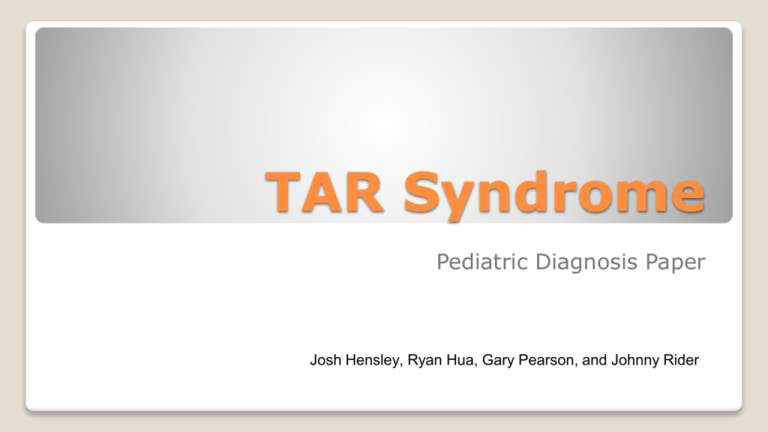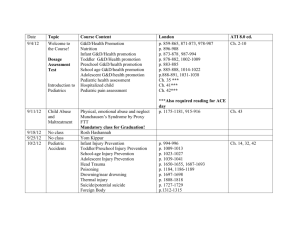TAR Syndrome
advertisement

TAR Syndrome Pediatric Diagnosis Paper Josh Hensley, Ryan Hua, Gary Pearson, and Johnny Rider TAR Syndrome Etiology and Prevalence • • • • • • • TAR syndrome is a genetic disorder which causes an absence of the radius in both forearms Other bones may be missing/abnormally formed but the thumb is present Shortage of blood cells which are involved in clotting Can result in easy bruising and frequent nosebleeds Severe hemorrhaging can occur in the brain especially during the first year of life and can be life threatening Hemorrhaging can lead to intellectual disabilities Short stature, smaller jaw bone, more prominent forehead, and lower set ears Etiology and Prevalence Cont. • • • • • RBM8A is the gene that causes TAR syndrome TAR syndrome is a rare disorder affecting less than 1 in 100,000 individuals Autosomal recessive pattern which is inherited, both copies of the genes are altered 40% die in infancy Additional impairments may include: lower body anomalies, intolerance to cow milk, renal and cardiac anomalies Description of Taylor • • • • • • 11 years old Loves to dance and host sleepovers Middle class family o Mother is a Registered Nurse o Father is a high school principal o Two older brothers and one older sister Lives in Riverton, Utah Homeschooled all her life Very involved in church and with extended family How TAR Syndrome Affects Performance • • • Note: Adapted on-suite in home Restricted ROM in both upper extremities Difficulties completing ADL’s such as: o Showering- Has adapted shower made personally for her o Dressing- Can’t dress self or tie shoes o Personal Device Care- Prosthetic leg o Personal Hygiene- Unable to Brush hair, brushing teeth is difficult w/out AE o Toileting- Can not wipe self. Donning and doffing clothes is very difficult. She can not button her pants. Effects On Performance Continued • • • • Public restrooms pose a problem o No bidet o Turning on faucet o Toilet hygiene Going up and down stairs with her prosthetic leg High-intensity activities such as sports Carrying a backpack/school supplies Assessment tools • • • Canadian Occupational Performance Model o To figure out Taylor’s priorities as well as her family’s priorities and goals which include as soccer, independence and attending public school Occupational Analysis on Taylor playing soccer (vestibular balance and equilibrium) Pediatric Evaluation of Disability Inventory o Self-care Bathing, Dressing, Toileting PEDI OA Model/Compensatory FOR • OA Model o Her condition does not allow for remediation o Best to alter task, person, and environment o Taylor prefers to have the quickest fix possible to become independent and wants more adaptive equipment Intervention Approaches • • Modification- Remediation is not likely and therefore modification is the quickest and easiest approach to enable Taylor to become as independent as possible. Restore/Create- due to her prosthetic leg, vestibular equilibrium is needed for proper balance. Taylor’s Prosthetics Used To Dance What activities can be implemented to promote higher level functioning? • Soccer (Taylor’s goal) o Self-esteem-part of team, leadership skills, and a sense of involvement o Psychosocial aspects o Physical health benefits and overall well-being o Functional mobility, balance, and ambulation. These can be generalizable to her everyday life Activities to promote higher level functioning continued • Self-Care o Adaptive equipment education Reaching aids Mounted wall hook (self dressing) Zipper pulls Buttoning aids Tissue wand or portable bidet o Toileting Pratice in public/school restrooms since she will be going to public school next year What is developmentally appropriate and functionally desired for Taylor? • Body image • Psychosocial development • Self-esteem • Coordination and motor control TAR Syndrome Questions 1) What would be the least effective model of practice/frame of reference to use for a child with TAR syndrome? A.) Compensatory B.) Psychosocial C.) Dynamical Systems D.) Biomechanical TAR Syndrome Questions Cont. 3) What musculoskeletal abnormalities are NOT typically present with TAR syndrome? A.) Absent thumbs B.) Short in stature C.) Underdevelopment of upper and lower limbs D.) Small lower jaw (mandible) E.) All of the above are typically present in TAR syndrome TAR Syndrome Questions Cont. 3) Occupational therapy for children/adolescents with TAR syndrome most closely aligns with treatment for which of the following? A.) Muscular Dystrophy B.) Limb deficiencies C.) ASD D.) Cerebral Palsy References Hall, J. G. (1987). Thrombocytopenia and absent radius (TAR) syndrome. Journal of Medical Genetics, 24, 79-83. Retrieved from http://www.ncbi.nlm.nih.gov/pmc/articles/PMC1049893/pdf/jmedgene00076-0015.pdf Hussey, S. M., & O’Brien, J. C. (2012). Introduction to Occupational Therapy. St. Louis, MO: Elsevier. Thrombocytopenia absent radius syndrome. (2011). Retrieved on November 8, 2013 from http://www.health24.com/medical/genetics/genes-and-disease/thrombocytopenia-absent-radius-syndrome20130312 Thrombocytopenia-absent radius syndrome. (2013). Retrieved on November 9, 2013 from http://ghr.nlm.nih.gov/condition/thrombocytopenia-absent-radius-syndrome Vroman, K. (2010). In Transition to adulthood: the occupations and performance skills of adolescents. In J. Case-Smith & J.C. O’Brien (6th Ed.), Occupational therapy for children (pp. 84-107). Maryland Heights, MO: Mosby Inc.





